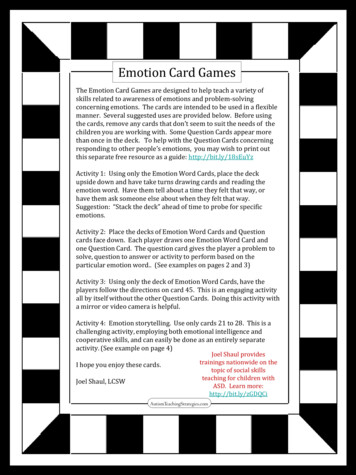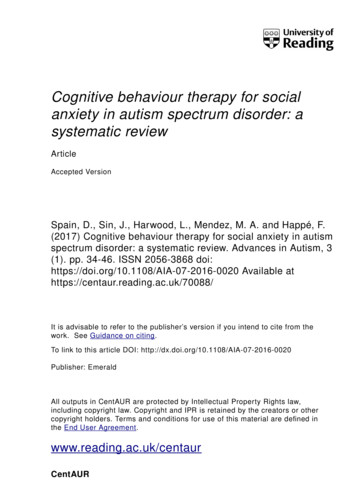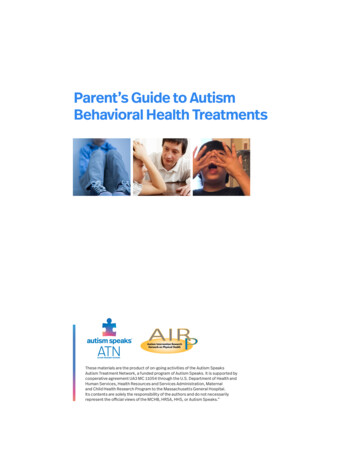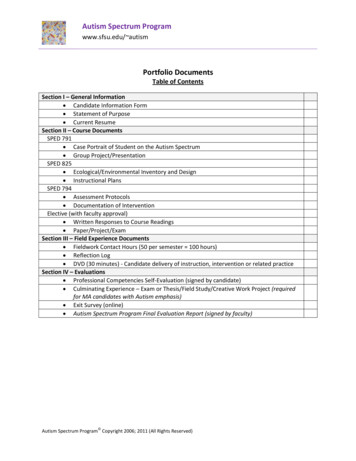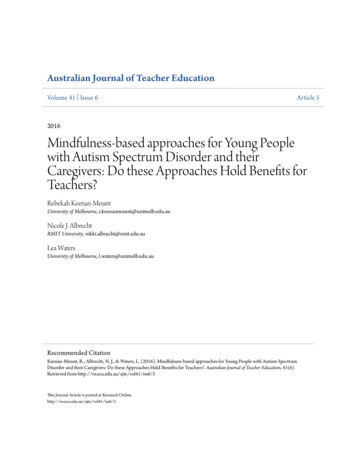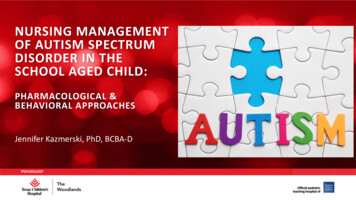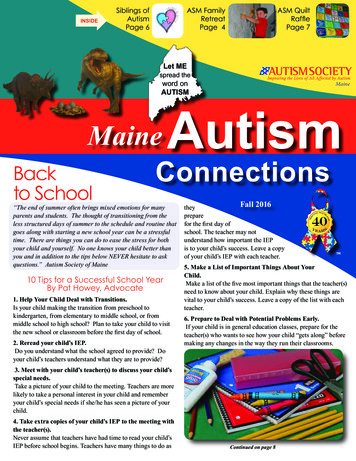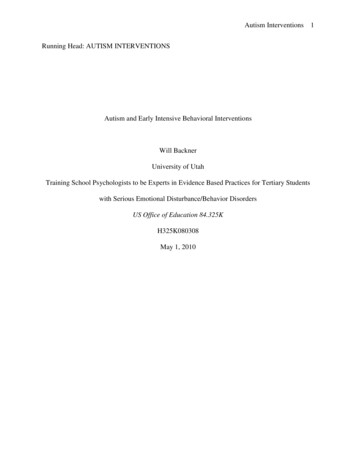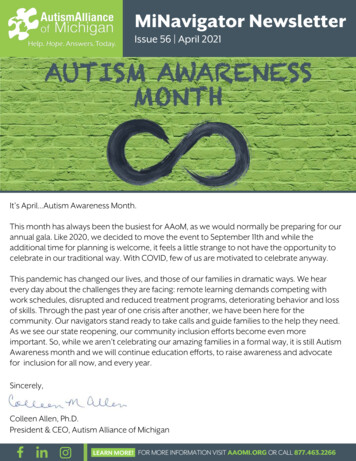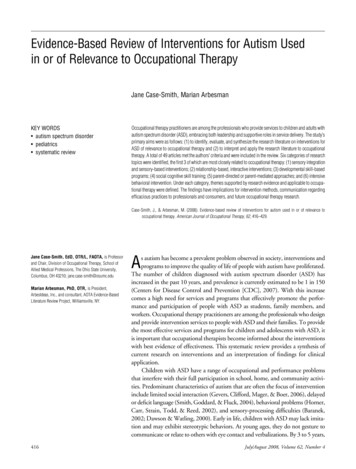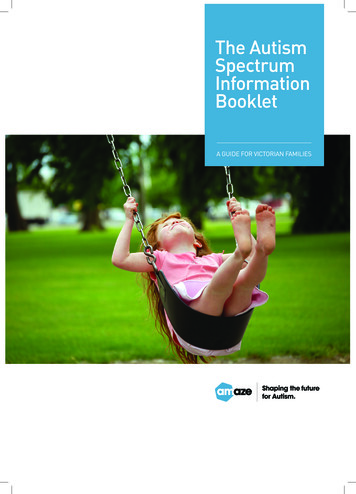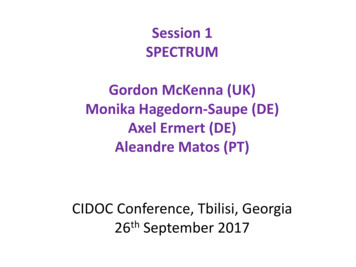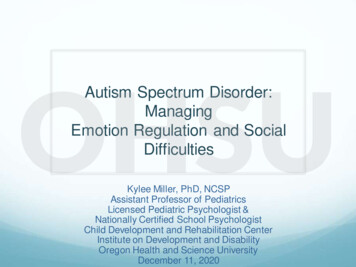
Transcription
OHSUAutism Spectrum Disorder:ManagingEmotion Regulation and SocialDifficultiesKylee Miller, PhD, NCSPAssistant Professor of PediatricsLicensed Pediatric Psychologist &Nationally Certified School PsychologistChild Development and Rehabilitation CenterInstitute on Development and DisabilityOregon Health and Science UniversityDecember 11, 2020
ObjectivesParticipants will be able to:OHSU Explain the emotion regulation and social challenges faced byindividuals with ASD and related disorders Describe the nature of social cognitive challenges in individualswith ASD and how these can affect social, academic, andbehavioral functioning Discuss selected emotional regulation and social cognitiveintervention strategies that can be taught to individuals with ASDand related disorders
Emotion Regulation Challenges inNeurodevelopmental DisabilitiesOHSU Cognitive/behavioral rigidity Anxiety; irritability Behavior self-monitoring and regulation Impulsivity Low frustration tolerance Emotion understanding/expression Challenging behaviors and self-injurySources: Lecavalier et al. (2006); Capps et al (1993); Jahromi et al. (2012); Mazefsky et al. (2014)
Social Challenges in ASDOHSUSpecific social challenges among individuals with ASD: Difficulties with social-emotional reciprocity (socialapproach and response) Difficulties with nonverbal communication (using andunderstanding facial expressions, gestures, cues, eyecontact) Relationship difficulties, limited social insight, difficultyadjusting behavior to social context, interest in others Repetitive/restricted interests and behaviors that areinterferingSource: DSM-5 (APA, 2013)
What factors contribute to socialand emotional difficulties in ASD?OHSU Neurodevelopmental differences (social information processing,emotion regulation, cognitive appraisal skills) Social cognition (“Theory of Mind”) difficulties Weak central coherence (bigger picture thinking) Executive functioning deficits Joint attention difficulties Communication impairmentSource: Insel & Fernald (2004); Adolphs et al. (2001); Schultz et al. (2006); Campbell et al. (2006); Rippon et al.(2007);Klin et al. (2002); Mazefsky et al. (2014) Image: www.autismtopics.org
Intervention is warranted whenbehaviors areOHSU harmful to the self or others unsafe or destructive distressing to the individual/family disruptive of learning disruptive of social functioning limiting participation in daily living or occupationalactivities6
Need for InterventionsOHSU Social impairments often become increasingly apparent into adolescence For high-functioning adolescents, social skills are typically the primary area ofdeficit High functioning individuals typically have increased awareness of socialdifferences and increased desire for social relationships Social difficulties interfere with peer relationships, school performance,occupational success, and adaptive functioning Adolescents with ASD are at an increased risk for loneliness, depression, andanxiety Evidence-based interventions are important for improving social functioning,broad mental health, and overall wellbeingSources: Paul (2003); Esbensen et al. (2009); Picci & Scherf (2014); Lasgaard et al. (2004)
Evidence Based TreatmentsOHSUComprehensive Treatment Models (CTM)Focused Intervention(e.g., LEAP, TEACCH, Denver Model)(e.g., shaping, visual supports)A set of practices used together to accomplish broadIndividual interventions used to address a skill orlearning or developmental impact on the core deficits of behavior present in an individual with IDD or ASDASD have a theoretical frameworkintenseoccur across yearstarget multiple outcomes (social,communication) operational defined, specific shorter time course (weeks–months) address specific outcomes Effective for broad range of ages, settings,behaviors Interventions can be used together with otherstrategies and interventions to target differentbehaviors specific interventions are often components ofCTMs8Wong, Odom, Hume, et. al. (2014) Evidence-Based Practices for Children, Youth, and Young Adults with Autism SpectrumDisorder
Evidence-Based Practices Identified by theNational Professional Development CenterOHSUPromptingNaturalistic InterventionsReinforcementPeer Mediated InterventionsTask Analysis and ChainingPivotal Response TrainingAntecedent-based interventionSocial Skills Training GroupsExtinctionSpeech Generating DevicesFunctional Communication TrainingComputer Aided InstructionFunctional Behavior AnalysisPicture Exchange CommunicationResponse Interruption/RedirectionVideo ModelingDifferential ReinforcementDiscrete Trial TrainingVisual SupportsTime delayStructured Work SystemsSelf-ManagementSocial NarrativesParent Implemented InterventionHume, K. A., & Odom, S. L. (2011). Best practices, policy, and future directions: Behavioral and psychosocialinterventions. In D. Amaral, G. Dawson, & D. Geschwind (Eds.), Autism spectrum disorders (pp. 1295- 1308). New York,NY: Oxford University Press.9
Features Across InterventionsOHSU Clear—understood by family/teachers/caregivers Consistent—family/school/caregivers are on the same page withthe interventions, expectations, and rewards Feasible—strategies need to be practical and available acrosssettings and team(s) Steady—new strategies/interventions should continue for at least3-4 weeks Continuity—keep strategies in place even when the behaviorimproves Remember Extinction Bursts Keep data10
Comprehensive Treatment ModelsApplied Behavior AnalysisOHSU
PrioritizeOHSU Set realistic goals Start with small steps that can build on each other Target behaviors that are dangerous Target skills that would help to improve situationsacross several settings12
OHSUSampling of emerging, promising, and establishedsocial cognitive and emotion regulation interventions
Social Skills Interventions:“Active Ingredients”OHSU Effective and engaging teaching practices for targetedpopulation Directly addresses underlying and overt difficulty areas Teaches skills that are developmentally appropriate Opportunities for direct feedback and coaching Group formats Promotes generalization of skills Focuses on bigger picture goals
Common Limitationsof Social Skills InterventionsOHSU Failure to assess treatment outcomes Failure to teach ecologically valid social skills Failure to include socialization assignments/additional practice Failure to generalize skills to other settings Failure to include caregivers in treatment In research, failure to use: Randomized controlled trials Independent raters Measures of sustained treatment outcomesSource: (Gresham, Sugai, & Horner, 2001; White, Keonig, & Scahill, 2007; DiSalvo & Oswald, 2002; Rogers, 2000; Rao, Beidel,Murray, 2008)
Peer MediatedIntervention andInstruction(PMII)OHSU Includes Peer Modeling, Peer Initiation Training, DirectTraining for Target Student and Peer, Peer Networks,Peer Supports Implemented in natural setting (e.g., at school lunch,recess, transitions between classes) – helps withgeneralization Increases positive interactions with peers
Social Narratives: SocialStories OHSU Developed by Carol Grey to teach children with ASDabout socials situations and how to act within thesesituations Written from the perspective of individual with ASD Uses minimum of 2-3 descriptive sentences for every 1directive sentence Descriptive: who, what, where, when, how, and perspectiveof others Directive: positive responses for the person with ASD (e.g., IfI want to say something in class, I can raise my hand andwait for the teacher to call my name before talking.) Read before targeted social situationhttp://carolgraysocialstories.com
Social Narratives: PowerCardsOHSU Uses an individual’s high interest character to show howto act in specific social situation Clearly defines how the individual can also use thesame behaviors in similar situations
Types of Video ModelingOHSU Video Modeling: record a model (peer, teacher, sibling)is recorded doing a targeted behavior, then the learnerwith ASD watches the video and is encouraged to copythe behavior Video Self Modeling: record the leaner with Asd doingtargeted behavior and edit out undesired behaviors Point-of-View Video Modeling: videoed from thelearner’s perspective as if watching him/herself performthe behavior Video Prompting: break down steps for a sequence ofskills; during pause between steps, the learner performseach step until sequence is finished
Social Thinking Is OHSU “A language and cognitive-based methodology thatfocuses on the dynamic nature of social interpretationand social communication skills, both of which requiresocial problem solving.” Used to translate evidence-based concepts intoconceptual frameworks, treatment fameworks,strategies, curricula, activities, and motivational tools
Social Thinking Is Based on.OHSUTheoretical Concepts Joint Attention Theory of Mind Executive Functioning Social Behavioral Learning
Social Thinking Is Made UpOf OHSU Visual Supports Visual Modeling Naturalistic teaching Self-management Positive Behavior Intervention and Supports (PBIS) Cognitive Behavioral Therapy (CBT)
EBP Vs PBEOHSU Visual Supports Visual Modeling Naturalistic teaching Self-management Positive Behavior Intervention and(PBIS) Cognitive Behavioral Therapy (CBT)Supports
OHSU
Specific Strategies of the SocialThinking ApproachOHSUby Michelle Garcia Winner and Pamela Crooke, Copyright2008
OHSU
Specific Strategies of the Social Thinking ApproachTEACHING SOCIAL THINKING IN PRESCHOOL AND EARLYELEMENTARYThe Incredible Flexible You CurriculumOHSUBy Ryan Hendrix, Kari Zweber Palmer, Nancy Tarshis, and Michelle Garcia Winner27
The Incredible Flexible You OHSU Curriculum for children ages 4-7 Language-based approach for childrenwith average to strong language andlearning abilities. Uses linked storybooks and lessonplans to teach Social Thinkingvocabulary– Books contain teaching momentsthroughout– Lesson plans include activities, dramaticplay, and music28
Specific Strategies of the SocialThinking Approach: OHSUSuperflexA Superhero Social Thinking CurriculumStephanie Madrigal and Michelle GarciaWinner(2008)www.socialthinking.com
The Superflex CurriculumProvides parents and educators with a fun,motivating, and non-threatening way forchildren to explore social thinking.OHSU This curriculum is designed to teachyounger children how to regulate theirbehaviors and become strongerproblem solvers. It helps children learn about their owninner Superflex and teaches themconfidence in their ability to be superheroic flexible social ingSelf-RegulationSelf-ControlSelf-Confidence
avioral interventions: Evidence-based practice for treating anxiety and moodrelated concerns Can be adapted for individuals with developmentaldisabilities, such as ASD Better suited for individuals with well developed cognitivereasoning skillsFacing Your Fears (Reaven et al., 2012): Group cognitive-behavioral intervention Focuses on emotion education, coping skills, and exposuretherapy Parent training componentOther support tools: Incredible 5-Point Scale (Buron et al., 2003) Zones of Regulation (Kuypers, 2011)Source: Wood et al. (2009); Storch et al. (2013)
The Incredible 5 Point ScaleOHSU A cognitive behavior technique to help students learn aboutpersonal behavior, emotions and self-control. Teaches Self-Awareness – sensory, emotions, behavior, copingtechniques. Can help adults more deeply understand the needsof the child so they can assist with teaching self-control, selfcalming strategies. Blends well with Social Behavior Map.Buron, K. D., & Curtis, M. (2003). The Incredible 5-Point Scale: Assisting students with autismspectrum disorders in understanding social interactions and controlling their emotional responses.Shawnee Mission, KS: Autism Asperger Publishing Company.
The Five Point ScaleOHSU
The Zones of RegulationOHSUKuypers, L., Zones of Regulation, Think Social Publishing, 2011
Big problem/Little problem?OHSU Scale 1-10 or 1-5 visual. List what type of problem is 10, 5, 1. Discuss descriptions of problems and determine where they fit onscale. Define what makes a problem big or small. What types of emotions are associated with different levels ofproblems? Discuss how different problem levels impact a situation over time. Discuss how to sort out and analyze that little problem. Discuss own emotions.
Calming StrategiesOHSU36
Take AwaysOHSU Pay attention to the behaviors you want more of. Behavior has a function. Find out what need thebehavior is meeting and help the child meet the need ina more appropriate way. Positive behavior strategies include teaching new skillsusing supports like visual cues and social stories aswell as environmental strategies like the use of calmdown spaces.37
Questions?OHSUEmail: MillerKy@ohsu.edu
Building Your and Caregivers’Awareness SkillsOHSU National Program: Learn the Signs. Act Early.(LTSAE; CDC) State Programs: Be Early (Part C) Office of Early Learning/Pre-K (Part B) Oregon Act Early (actearlyoregon.org)
CDC Autism Case TrainingOHSUIndividual Modules Identifying Diagnosing Managing Online Course Available CE credit
Web ResourcesOHSU CDC Learn the Signs/Act Early www.cdc.gov/ncbddd/actearly/concerned/html Oregon Act Early www.actearlyoregon.org American Academy of Pediatrics http://www.aap.org/healthtopics/autism.cfm Autism Speaks ASD glossary http://www.autismspeaks.org/ CSBS Infant/Toddler Checklist & Scoring, ASD glossary http://firstwords.fsu.edu
ResourcesOHSU Talking to Parents About Autism an excellent 15 min video via YouTube by Autism Speaks www.autismspeaks.org/whatisit/talking to parents action kit.php#top also includes an “action kit” with handouts for early care andeducation providers to talk with parents about developmentalscreening Caring for children with autism spectrum disorders: aresource toolkit for clinicians Retrieved September 23, 2012, from American Academy ofPediatrics website: http://www2.aap.org/publiced/autismtoolkit.cfm#id
ResourcesOHSU Modified Checklist for Autism in Toddlers Retrieved September 25, 2012, from Autism Speaks andHearing Association website: creen-your-child http://www2.gsu.edu/ psydlr/Diana L. Robins, Ph.D.html American Academy of fm National Professional Development Center on AutismSpectrum Disorders (24 evidence-based practices,training modules, online course)(http:www.fpg.unc.edu/ autismpdC/)
ResourcesOHSU The Iris Center, Vanderbilt University, FunctionalBehavioral le/fba/challenge/#content Behaviorbabe.com video on Functions of behavior44
ResourcesOHSU Carol Gray Social tories/ Autism Speaks Social s/personalized-stories Zones of Regulation, https://www.socialthinking.com/ Do 2 Learn,http://www.do2learn.com/45
Video Self Modeling: record the leaner with Asd doing targeted behavior and edit out undesired behaviors Point-of-View Video Modeling: videoed from the learner's perspective as if watching him/herself perform the behavior Video Prompting: break down steps for a sequence of skills; during pause between steps, the learner performs
